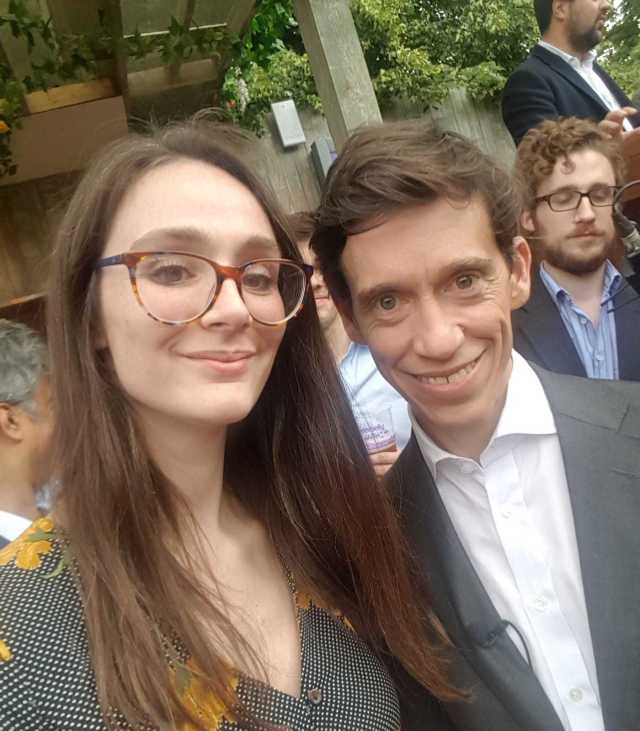Our producer, Danni Boxall and Rory Stewart and his ‘losing party’
I didn’t expect my curiosity about Rory Stewart to make the front pages. But last week, on Friday morning, there I was: right at the top of MailOnline, pictured standing shoulder to shoulder with the man who had managed to electrify Twitter (if not his fellow Conservative MPs) with his left-field leadership campaign.

I had gone along to what was being described as his ‘losing party’ to see what the fuss was about. True, I had been impressed by the energy and enthusiasm of his walking tour from Warrington to Wigan, via Belfast and Edinburgh. But could the reality live up to the online hype?
I arrived to find around 600 fans packed into a small courtyard, eagerly awaiting their new hero’s arrival. “If Rory went to Glastonbury, he’d get just as big a response as Jeremy Corbyn,” said the excitable 17-year-old next to me.
The crowd loved him, whooping and cheering as he leapt on to the stage. “You’re much more interesting than me because you’re more diverse than I am,” he told the gathered throng. Though a quick glance around showed only a sea of young white men, shiny-faced and besuited. He must have been referring to followers of his wider movement.
Rory’s talk was rousing. He talked about compromise and coalitions, and beseeched us to join ‘his movement’. The crowd was right behind him. I found myself slightly swept along. So much so, that afterwards I actually queued up in the hope of a handshake and a selfie. In it, I found a little diversity. One woman told me she’d “sign up for Rory Party, but not the Tory Party”. Another explained why the Rory bandwagon should swing by Sheffield to pick up her friends who are not Tories but are enthused by his honesty and vision for a fairer society.
He had also picked up a new fan during the previous Sunday’s leadership debate. The woman who’d asked the candidates if they’d be willing to suspend parliament to break the Brexit deadlock forced her way to the front of the line to tell Rory, “I’m a Lib Dem, but after your answer on Sunday, I’d vote for you.”
As I approached the hero of the hour, I was elbowed aside by a middle-aged man introducing himself as the head of a local ‘Conservatives for a People’s Vote’ campaign. He was desperate to tell Rory about his shock that 57% of Tory members want to pursue a no deal Brexit. Rory, I was surprised to note, wasn’t so keen to talk about it.
In his speech, Rory had encouraged the audience to accept differing opinions and everyone’s individuality. But I don’t imagine many of the audience were Leavers. And that may prove problematic for Stewart. Those Brexit bashing fans could block his movement from extending out of the London liberal bubble. If he is going to remove that great wedge driven into society, Rory needs a fan base that is ready to move on.
When I finally came face-to-face with him, he seemed like a different man from the ball of energy I’d seen on stage a few minutes before. Weeks of tireless campaigning, early morning radio and late-night TV had taken their toll: his face looked worn and tired, and bloodshot eyes accentuated the pale and sunken skin smudged with foundation, the residue of the TV studios.
It had clearly been a huge effort to get this far; maintaining momentum now he’s out of the leadership race will be a struggle. Especially if he’s going to try to re-energise the centre ground one person at a time.
But watching him listening and trying to understand people felt strangely affecting. And refreshing. It’s hard not to admire a politician who can mingle seemingly effortlessly with the public for well over two hours.
So I nervously began to talk about the failure of contemporary centrist movements to make a real impact. Rory nodded. Encouraged, I continued to waffle on about how politicians don’t truly value the insight of the public or seek to venture outside of the ‘Westminster bubble’. “Thank you,” he replied, earnestly.
Frankly, this was a bit of a disappointment. I’d expected something more substantial in response. “Thank you?” Was that it? I felt a little short-changed as I took my selfie and turned away.
But, then, when I re-played our encounter in my head on my way home, once my nerves had abated, I realised I’d fallen into the trap of projecting my world view onto him. It’s hard to see how else he might have responded.
These days, the idea that a big political figure might be willing to engage with the voting public is an alien one. May had a reputation for being whisked away before she could be questioned by the electorate; Boris Johnson has done everything in his power to avoid speaking to anyone or anything during his leadership campaign. More and more, our politicians seem disconnected from the people. It’s no wonder they’re repeatedly surprised by the messages the electorate keep sending them.
If we want our politicians to listen, then we have to be ready when they do just that. Rory listened and digested, rather than trying to work out what line to spin me. It weirdly felt like he valued me.
Before seeing Rory first-hand, part of me had cynically believed that his following was manufactured. But leaving, I felt I understood better why Rory’s walking tour had been such a success – he could make people feel that their opinion was worthwhile, that they were a little bit special.
As I pondered this, my friend interrupted my political epiphany with a screenshot. It was of a face beaming out from the front page of Mail Online alongside Rory. My face. Why had they picked that shot? Did I look like an archetypal Rory-ista, I wondered. And for the first time I actually thought: maybe I am.









Join the discussion
Join like minded readers that support our journalism by becoming a paid subscriber
To join the discussion in the comments, become a paid subscriber.
Join like minded readers that support our journalism, read unlimited articles and enjoy other subscriber-only benefits.
Subscribe